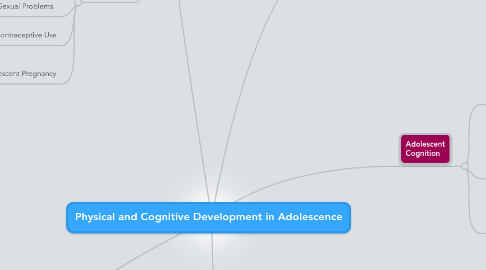
1. Adolescent Cognition
1.1. Piaget’s Theory
1.1.1. formal operational stage.
1.1.2. start to think reality rather thn abstract mcm nk solve prob
1.1.3. Hypothetical-Deductive Reasoning
1.1.3.1. algebraic equation
1.1.3.2. during secondry kite kne pilih sains & art
1.2. Adolescent Egocentrism
1.2.1. types of social thinking –imaginary audience( belief others are as interested in them) "on stage" –personal fable ( perasan bagus tp dlm hati)
1.3. Information Processing
1.3.1. Decision Making - do our own decision
1.3.2. Critical Thinking(type of reasonable, reflective thinking that is aimed at deciding what to believe or what to do) -increased ability to construct new knowledge combinations
2. Schools
2.1. Transition to Middle or Junior High School
2.1.1. top-dog phenomenon - mase skola rendah jd ketua pngwas pastu menengah jd form 1
2.1.2. Positive Changes in the Transition to Middle School -feel grown up -independence
2.2. Service Learning
2.2.1. -plkn -service to the community -more motivated to help others
3. The Nature of Adolescence
3.1. Relationships w parents take a different form. -parents will let us go sbb kite dah teenager
3.2. Dating occurs for the first time
3.3. •Thoughts are more abstract and idealistic. -start to think who r we going 2 b
3.4. heightened interest in body image.
3.5. Adolescents not homogeneous group
3.5.1. die heterogenous boleh bersosial dgn org
4. Adolescent Problems and Health
4.1. Substance Use and Abuse
4.1.1. Cigarette Smoking
4.2. Eating Problems and Disorders
4.2.1. Anorexia Nervosa
4.2.1.1. An eating disorder that involves the relentless pursuit of thinness through starvation; can lead to death.
4.2.1.1.1. takut nk mkn
4.2.2. Bulimia Nervosa
4.2.2.1. consistently follows a binge-and-purge eating pattern.
4.2.2.1.1. makan muntah blk
4.2.2.1.2. sush nk detect sbb die mkn cm biase tp muntah blk
4.3. Adolescent Health
5. Puberty and Sexuality
5.1. •Puberty-rapid physical maturation involving hormonal and bodily changes in early adolescence
5.2. Pubertal Changes
5.2.1. onset of puberty –Nutrition –Health –Heredity –Body Mass
5.2.2. Hormonal Changes
5.2.2.1. chemical from endocrine glands and carried through the body by the bloodstream
5.2.2.2. Testosterone-boys progesterone,Estradiol-girls
5.2.3. The Endocrine System
5.2.3.1. Hypothalamus-monitor eat,drink
5.2.3.2. Pituitary gland (interact w thyroid gland for growth n skeletal)
5.2.3.3. Gonads
5.2.4. Height and Weight
5.2.4.1. Mean beginning of the growth spurt - age 9=girls age 11 for boys.
5.2.5. Sexual Maturation in Boy -detectable voice change
5.2.6. Sexual Maturation in Girls -First menstruation
5.2.7. Body Image
5.2.7.1. develop individual images of what their bodies are like
5.2.7.1.1. girls start 2 think about diet, make-up, matching clothes
5.2.7.2. girls-dissatisfied w increase in body fat boys-satisfied increase in muscle mass
5.2.8. Early and Late Maturation in Boys
5.2.8.1. Early maturing boys more positively & more successful relations
5.2.9. Early and Late Maturation in Girls
5.2.9.1. early-maturing ade prob kat school & more independence
5.2.10. not sudden event -bukan tetibe je, ade peringkat2
5.3. Adolescent Sexuality
5.3.1. •Adolescence is a time of sexual exploration and experimentation.
5.3.2. Developing a Sexual Identity
5.3.2.1. Learn to manage sexual feelings
5.3.2.2. skills to regulate sexual behavior to avoid undesirable consequences. ( cam terlanjur n ade anak luar nikah
5.3.3. The Progression of Adolescent Sexual Behaviors
5.3.4. Risk Factors for Sexual Problems
5.3.4.1. at risk for sexual transmitted disease (STD) (Chlamydia and gonorrhea)
5.3.5. Contraceptive Use
5.3.5.1. risks can be reduced
5.3.6. Adolescent Pregnancy
5.3.6.1. Consequences –low birthweights –neurological problems –childhood illness
